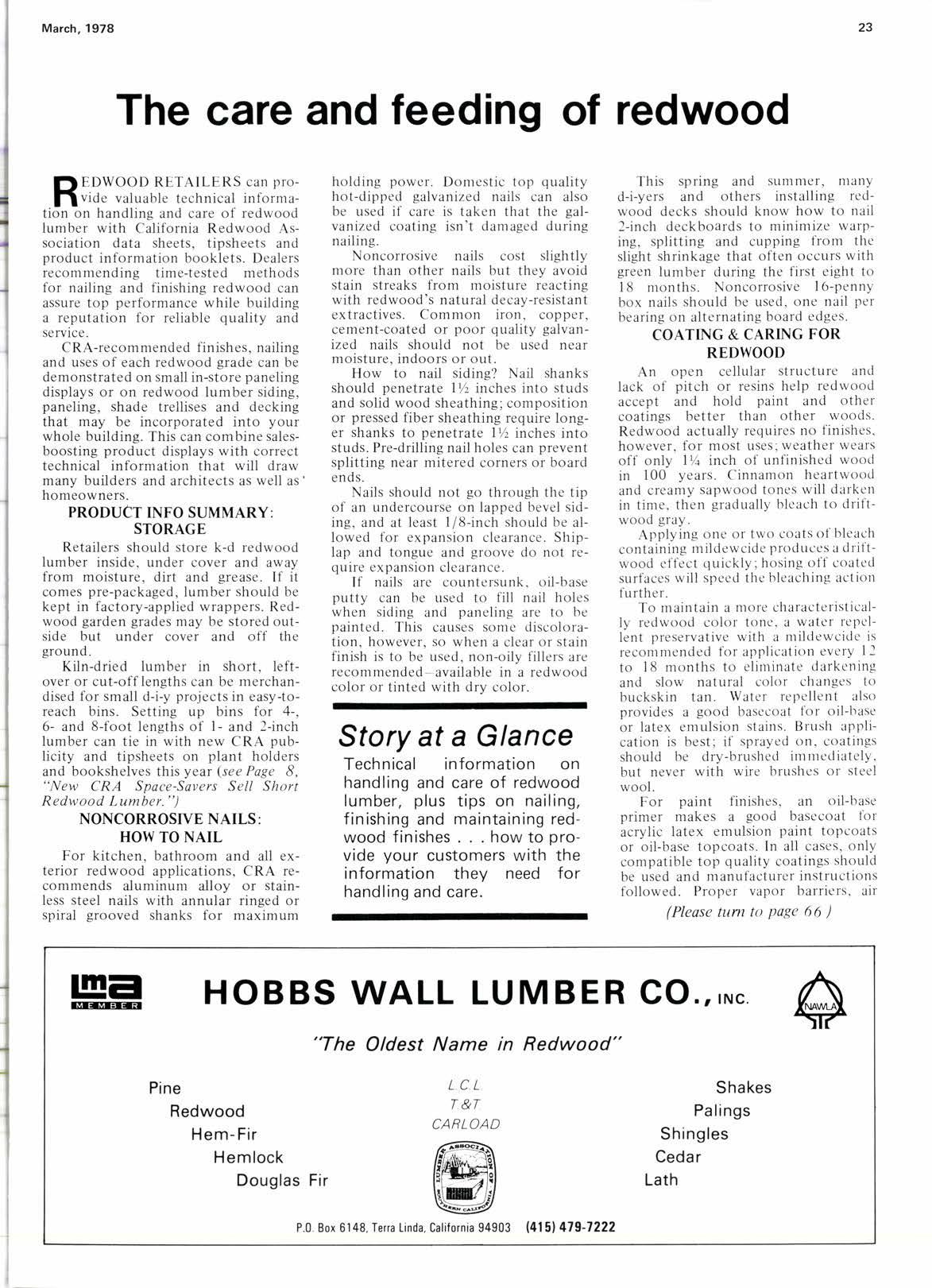
3 minute read
The care and feeding of redwood
FIEDWOOD RETAILERS can pro|r[vide valuable technical infornration on handling and care of redwood lumber with California Redwood Association data sheets, tipsheets and product information booklets. Dealers recommending timetested methods for nailing and finishing redwood can assure top performance while building a reputation for reliable quality and servlce.
CRA-recommended finishes, nailing and uses of each redwood grade can be demonstrated on small in-store paneling displays or on redwood lumber siding, paneling, shade trellises and decking that may be incorporated into your whole building. This can combine salesboosting product displays with correct technical information that will draw many builders and architects as well as' homeowners.
PRODUCT INFO SUMMARY: STORAGE
Retailers should store k-d redwood lumber inside, under cover and away from moisture, dirt and grease. If it comes pre-packaged, lumber should be kept in factory-applied wrappers. Redwood garden grades may be stored outside but under cover and off the ground.
Kiln-dried lumber in short, leftover or cut-offlengths can be merchandised for small d-!y projects in easy-toreach bins. Setting up bins for 4-, 6- and 8-foot lengths of 1- and 2-inch lumber can tie in with new CRA publicity and tipsheets on plant holders and bookshelves this year (see Page 8, "New CRA Space-Savers Sell Short Redwood Lumber.")
NONCORROSTVE NAILS: HOW TO NAIL
For kitchen, bathroom and all exterior redwood applications, CRA recommends aluminum alloy or stainless steel nails with annular ringed or spiral grooved shanks for maximum holding power. Donrestic top quality hot-dipped galvanized nails can also be used if care is taken that the galvanized coating isn't damaged during nailing.
Noncorrosive nails cost slightly more than other nails but they avoid stain streaks from moisture reacting with redwood's natural decay-resistant exlractives. Common iron. copper. cement-coated or poor quality galvanized nails should not be used near moisture. indoors or out.
How to nail siding? Nail shanks should penetrate 1% inches into studs and solid wood sheathing; composition or pressed fiber sheathing require longer shanks to penetrate 1% inches into studs. Pre-drilling nail holes can prevent splitting near mitered corners or board ends.
Nails should not go through the tip of an undercourse on lapped bevel siding, and at least l/8-inch should be allowed for expansion clearance. Shiplap and tongue and groove do not require expansion clearance.
If nails are countersunk. oil-base putty can be used to fill nail holes when siding and paneling are to be painted. This causes some discoloration, however, so when a clear or stain finish is to be used, non-oily fillers are recommended..available in a redwood color or tinted with dry color.
Story at a Glance
Technical information on handling and care of redwood lumber, plus tips on nailing, finishing and maintaining redwood f inishes . . how to provide your customers with the information they need for handling and care.
This spring and summer, nlany d-i-yers and others installing redwood decks should know how to nail l-inch deckboards to minimize warping, splitting and cupping frorn the slight shrinkage that often occurs with green lumber during the first eight to 18 nronths. Noncorrosive l6-penny box nails should be used, one nail per bearing on alternating board edges.
COATING & CARING FOR REDWOOD
An open cellular structure and lack of pitch or resins help redwood accept and hold paint and other coatings better than other woods. Redwood actually requires no finishes, however, for most uses, weather wears off only 17a inch of unfinished wood in 100 years. C-innamon heartwood and creamy sapwood toncs will darken in time, then gradually blcach to driftwood gray.
Applying onc or two coats of bleach containing mildewcide produces a driftwood effect cluickly; hosing off coated surfaces will specd the bleaching action fu rther.
To maintain a more characteristically redwood color tonc, a watcr repellent preservative with a ntildewcidc is reconrnrended for application every l2 to l8 months to eliminate darkening and slow natural color changes tct buckskin tan. Water repellent alscr provides a good basecoat for oil-base or latex emulsion stains. Brush application is best; if sprayed on, coatings should be dry-brushed imrnecliately, but never with wire brushes or steel wool.
For paint finishes, an oil-base primer makes a good basccoat 1or acrylic latex emulsion paint topcoats or oil-base topcoats. In all cases, only compatible top quality coatings should be used and manufacturer instructions followed. Proper vapor barriers, air (Please tum to page 66 )










